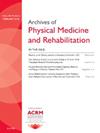Long-term Comparative Effectiveness of Surgical Versus Non-surgical Treatment for Rotator Cuff Tears: 5-Year Follow-up of a Prospective Cohort Study 8265
IF 3.6
2区 医学
Q1 REHABILITATION
Archives of physical medicine and rehabilitation
Pub Date : 2025-04-01
DOI:10.1016/j.apmr.2025.01.014
引用次数: 0
Abstract
Objectives
To investigate the long-term effect of operative versus conservative treatments for rotator cuff tears (RCTs), because insufficient long-term evidence exists for the decision-making process.
Design
A multicenter prospective longitudinal cohort study with a follow-up of over 5 years. Follow-up visits were set at 3, 6, 12, 18, 24, 36, 48, and 60 months. Inverse probability weighting was used to balance differences in baseline characteristics of the operative and nonoperative groups. Generalized linear mixed model and 3-way interaction were applied in the main and subgroup analysis.
Setting
Sports or shoulder clinics in 3 academic settings and 1 community setting between March 2011 and February 2015.
Participants
Patients over 45 years of age who were diagnosed with RCTs.
Interventions
Not applicable because it is a prospective cohort study.
Main Outcome Measures
Assessments included the Shoulder Pain and Disability Index, the American Shoulder and Elbow Surgeons form, magnetic resonance imaging, and a detailed health history questionnaire.
Results
After Inverse probability weighting, both groups (operative, n=50; nonoperative, n=77) displayed similar baseline demographics. Outcomes were comparable between groups until 18 months after intervention. Beyond this period, the operative group demonstrated significantly improved outcomes in both Shoulder Pain and Disability Index and American Shoulder and Elbow Surgeons scores. Adjusted mean differences in Shoulder Pain and Disability Index scores were −11.6 (95% confidence interval [CI], −23.3 to 0.137; P=.0527) at 12 months, −12.75 (95% CI, −22.6 to −2.957; P=.0107) at 18 months, and −9.48 (95% CI, −14.5 to −4.41; P<.0001) at the 5-year mark. Subgroup analyses revealed that women (P=.0126) and patients with traumatic RCTs (P<.0001) benefitted more from surgical interventions than from nonoperative treatment.
Conclusions
Surgical intervention for RCTs leads to more substantial functional improvement than nonoperative methods after 18 months and remains stable up to 5 years. Female patients and those with traumatic RCTs are more likely to experience better long-term functional outcomes after surgery. This research provides insights into recovery timelines, which can support patient-centered decision making.
Disclosures
none.
求助全文
约1分钟内获得全文
求助全文
来源期刊
CiteScore
6.20
自引率
4.70%
发文量
495
审稿时长
38 days
期刊介绍:
The Archives of Physical Medicine and Rehabilitation publishes original, peer-reviewed research and clinical reports on important trends and developments in physical medicine and rehabilitation and related fields. This international journal brings researchers and clinicians authoritative information on the therapeutic utilization of physical, behavioral and pharmaceutical agents in providing comprehensive care for individuals with chronic illness and disabilities.
Archives began publication in 1920, publishes monthly, and is the official journal of the American Congress of Rehabilitation Medicine. Its papers are cited more often than any other rehabilitation journal.

 求助内容:
求助内容: 应助结果提醒方式:
应助结果提醒方式:


